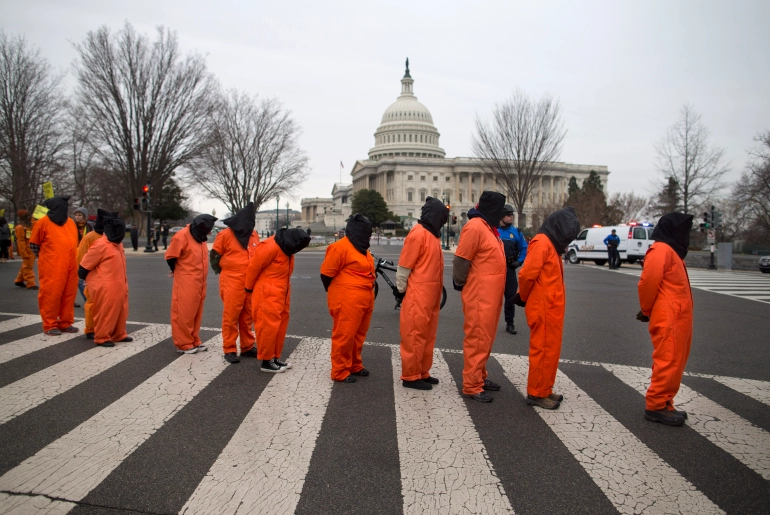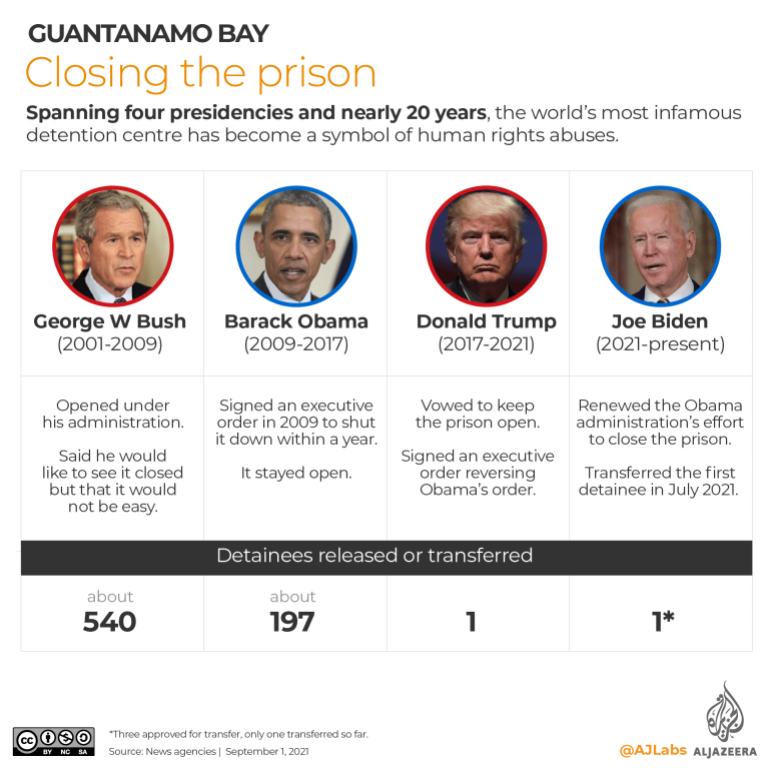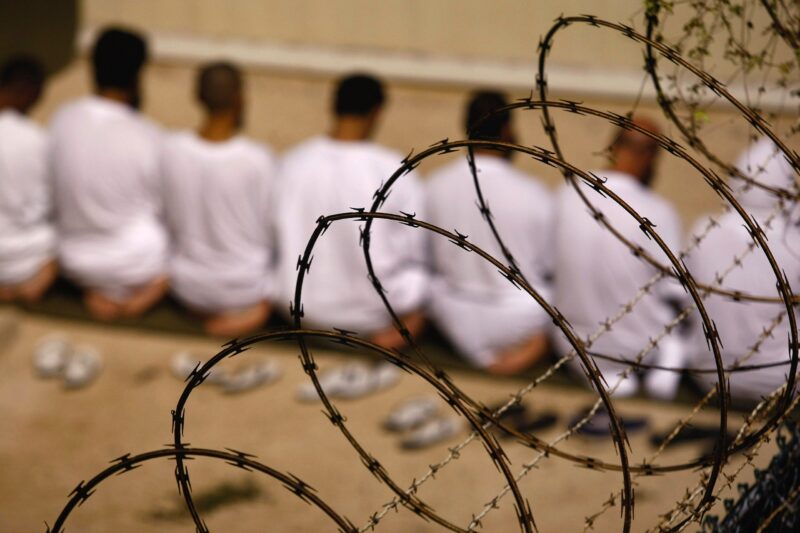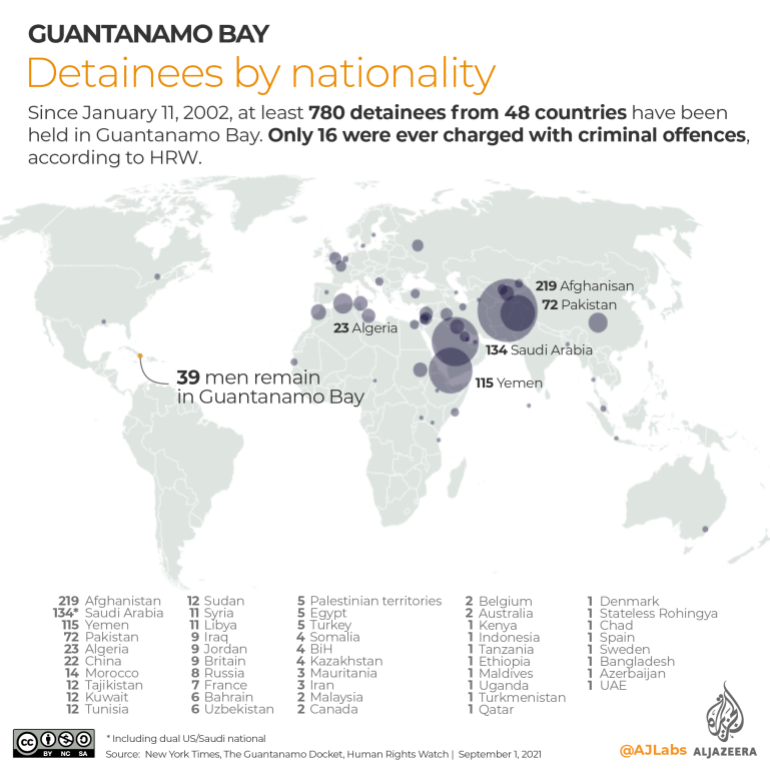Guantanamo Bay, the United States controlled prison in Cuba, created in the aftermath of 9/11 completes 20 years today.
The prison allows detainees to be held indefinitely outside of normal laws or judicial oversight, according to various human rights bodies.
This inhumane facility was a result of the so called ‘war on terror’ by the US across the world.
During the past two decades, 780 men have passed through the facility, today, the facility holds 39 men, according to disclosures from the US government’s interagency Periodic Review Board made in October.
Here is a look at 20 years of US Torture, the story of Guantanamo Bay Prison, a story of wrongful detentions, tortures and failure of world at large.
November 13, 2001: The Order
George W Bush, the US president, issues a military order on the “Detention, Treatment and Trial of Certain Non-Citizens, in the War Against Terrorism”.
The order authorises the US to hold foreign nationals in custody without charge indefinitely, and prevents them from undertaking any legal process to challenge their detention.
December 28, 2001: No Habeas Corpus Rights
A memorandum from the US Justice Department to the Pentagon explains that prisoners held in Guantanamo Bay are not eligible for habeas corpus rights protecting against arbitrary detention because they are not on US soil.
January 11, 2002: First Prisoners
The first 20 detainees arrive at Guantanamo Bay’s Camp X-Ray and are held outdoors in wire mesh cages.
January 18, 2002: Red Cross Visits, Bush Defends.
The International Committee of the Red Cross begins visiting prisoners in Guantanamo Bay. On the same day, the Bush administration rules that Guantanamo prisoners do not qualify as prisoners of war and are not entitled to the protection of the Geneva Convention.
January 27, 2002: Dangerous Prisoners
Dick Cheney, the US vice president, describes the prisoners as “the worst of a very bad lot,” adding that: “They are very dangerous. They are devoted to killing millions of Americans.”
February 21, 2002: Judge Dismisses Challenge
A US federal judge dismisses a challenge to the detention of prisoners at Guantanamo Bay filed by the Center for Constitutional Rights, a legal advocacy group.
April 5, 2002: First Prisoner Transfer
Prisoner Yaser Esam Hamdi is transferred from Guantanamo to military custody on the mainland after it is discovered he was born in the US state of Louisiana.
April 25, 2002: Camp Delta
Construction of the new Camp Delta, a permanent prison facility with a capacity of more than 400, is completed.
August 1, 2002: Torture is Legal
A memorandum from the Department of Justice to then-White House Counsel Alberto Gonzales advises that the president can authorise a wide range of “enhanced interrogation techniques” that would not amount to torture and therefore not be prosecutable under US law.
Even if torture did occur, the memorandum argues, the theory of “necessity” or “self-defence” could be used to eliminate any criminal liability.
September 15, 2002: First Prisoner Sent To Afghanistan
One prisoner, Abdul Razaq, becomes the first inmate to be repatriated to Afghanistan.
December 2, 2002: New Interrogation Techniques
Donald Rumsfeld, the US defence secretary, approves a range of interrogation techniques for use at Guantanamo including sensory deprivation, isolation, stress positions and the use of dogs to “induce stress”.
May 2003: Prisoners Increase.
Guantanamo prison population reaches 680 detainees.
July 3, 2003: Military Tribunal.
Bush designates six suspected members of al-Qaeda eligible for the first military tribunals since the second world war.
October 9, 2003: Red Warning
The Red Cross warns of the “deterioration in the psychological health of a large number of detainees”.
November 10, 2003: Challenge Detention
The US Supreme Court agrees to hear appeals in the Guantanamo case over whether inmates have a right to access civilian courts to challenge their indefinite detention.

December 3, 2003: Lawyer is Given.
David Hicks becomes the first Guantanamo prisoner to be given a lawyer.
January 12, 2004: Unconstitutional Rules.
Five military lawyers assigned to defend detainees say they believe that some of the rules drawn up for the military tribunals are unconstitutional.
February 23, 2004: First Charges
The Bush administration brings the first charges against detainees. Ali Hamza al-Bahlul from Yemen and Ibrahim al-Qosi from Sudan are charged with conspiracy to commit war crimes.
June 28, 2004: Federal Authority.
The Supreme Court rules that the federal courts have the authority to decide whether non-US citizens detained in Guantanamo Bay are wrongfully imprisoned, and that the executive branch does not have the power to hold indefinitely a US citizen without basic due process protections enforceable through judicial review.
July 7, 2004: Military Panels Launched.
The Pentagon launches military panels, known as Combatant Status Review Tribunals or CSRTs, to determine the “enemy combatant” status of each prisoner.
August 13, 2004: Tribunals
Review tribunals begin.
October 27, 2004: Fight For Rights.
Four former British detainees launch legal action against the US government. In the first case of its kind, Rasul, Iqbal, Ahmed and al Harith each demand $9m as compensation for alleged torture and other human rights violations. The Pentagon declares that the men are not entitled to a payout because they were captured “in combat”.
March 29, 2005: Eligible For Release.
The CSRT process is completed. Of the 558 detainees assessed, 38 were judged as “no longer enemy combatants” and were made eligible for release.
April 19, 2005: Press For Justice
The Associated Press launches legal action against the US Department of Defense in an attempt to force the release of transcripts and other documents related to Guantanamo military hearings.
May 20, 2005: Documents Released
The Associated Press lawsuit results in the release of nearly 2,000 pages of documents, although detainees’ names and nationalities blacked out. The documents include excerpts from prisoners’ testimonies.
August 29, 2005: Personal Information
US District Judge Jed Rakoff orders the government to ask each prisoner whether they want personal information that could be used to identify them to be released to the Associated Press.
Of 317 detainees who received the form, 63 said yes, 17 said no, 35 returned the form without answering and 202 did not return the form.
December 30, 2005: Detainee Act.

The Detainee Treatment Act comes into law. The Act bans the use of cruel, inhuman or degrading treatment of prisoners, but severely curtails their right to challenge their detention.
February 15, 2006: UN Wakes Up
UN report recommends closure of Guantanamo.
February 23, 2006: Release of Indentities
The Pentagon is ordered to release the identities of hundreds of Guantanamo prisoners to the Associated Press as a result of its Freedom of Information Act lawsuit.
April 20, 2006: Names Given
The Department of Defense releases the names of 558 people who have been held at Guantanamo Bay.
May 2006: Riot
Repatriations for detainees continue for countries in Europe, the Middle East, Asia and Africa. Two Guantanamo detainees attempt suicide and a riot breaks out in reaction to the event.
June 10, 2006: Deaths
Saudi Arabian nationals Mani Shaman Turki al-Habardi al-Utaybi and Yasser Talal al-Zahrani, and Ali Abdullah Ahmed of Yemen, die by apparent suicide.
September 6, 2006: Secret Sites.
Fourteen “high value” detainees are transferred to Guantanamo from secret sites.
September 26, 2006: Meeting Prisoners.
The Red Cross sends a delegation to Guantanamo to meet with the 14 newly transferred prisoners.
October 17, 2006: US Courts lose Jurisdiction.
President Bush signs the Military Commissions Act into law. The Act strips US courts of jurisdiction to hear habeas corpus appeals from any foreign national held as an “enemy combatant” in US custody anywhere in the world.
It also narrows the scope of the War Crimes Act, by not expressly criminalising Common Article 3’s prohibition on unfair trials or “outrages upon personal dignity, in particular, humiliating and degrading treatment”. The Act will allow the CIA’s secret detention programme to continue.
March 18, 2007: Released But Captive.
Two UK residents, Ahmed Rashidi and Ahmed Belbacha are cleared by a Pentagon tribunal for release from the prison but face indefinite detention because the UK refuses to authorise their release.
March 26, 2007: Direct Prisoner Transfer.
Abdul Malik Abdul-Jabbar, a citizen of Kenya, is transferred to Guantanamo Bay, marking the first time since September 2004 that a detainee has been directly transferred to Guantanamo.
Repatriations of detainees to other countries continue throughout the year.
May 20, 2008: First Testimony
Murat Kurnaz becomes the first ex-Guantanamo detainee to testify before the US Congress, which he does from Germany via videolink.

June 12, 2008: Right To Challenge.
The United States Supreme Court rules on Boumediene v Bush and Al Odah v United States that detainees at Guantanamo Bay should have a right to challenge their detention in US Federal Courts through habeas corpus petitions.
November 16, 2008: Obama
Barack Obama, then a candidate for US president, declares his intention to close Guantanamo.
January 14, 2009: Admission of Torture.
A public statement admitting that a detainee was tortured is released for the first time by a senior Bush administration official responsible for reviewing practices at Guantanamo Bay.
The statement admitted that the treatment of a Saudi national met the legal definition of torture.
January 22, 2009: Obama Issues Orders
President Obama issues three executive orders: one ordering the closure of the prison at Guantanamo Bay in one year, another banning the use of controversial CIA interrogation techniques, and a third ordering a review of detention policy options.
May 15, 2009: Lakhdar Boumediene
Inmate Lakhdar Boumediene is transferred to France. He had been held since 2002 and had been used by lawyers to win the landmark Supreme Court case which ruled detainees at Guantanamo Bay had the right to habeas corpus.
Meanwhile, President Obama announces he will continue with the much-criticised system of military tribunals that President Bush created to try terrorism suspects, albeit in a different form.
June 9, 2009: First Detainee
The first detainee, Ahmed Ghailani, who is not an American citizen is brought from Guantanamo Bay to the US mainland to face a federal trial. He is eventually given a life sentence for his role in bombing US embassies.
June 11, 2009: Youngest Prisoner.
Mohammed el Gharani, the youngest prisoner to be held in Guantanamo Bay, is released. He was 14 when he was arrested in Pakistan in 2001.
November 2009: Missed Deadline
Obama admits a planned deadline for closing the facility by January 2010 will be missed.
January 22, 2010: Held Without Charges
The US Justice Department determines that nearly 50 of the remaining 196 detainees in Guantanamo Bay should be held indefinitely without charges or trial. A hand full of detainees face military tribunals through the rest of the year.
March 7, 2011: Broken Promise
Obama signs an executive order to resume military trials at Guantanamo Bay, formally establishing a system to hold some detainees indefinitely breaking one of his campaign promises.
April 4, 2011: Prosecution of 9/11 Accused.
Attorney General Eric Holder announces a decision to prosecute five men accused of plotting the September 11, 2001 attacks before a military commission at Guantanamo Bay.
April 24, 2011: Innocent Men Held.
WikiLeaks releases classified US military files, showing that Guantanamo Bay held more than 150 innocent men for years. By this time, 604 inmates have been transferred out of the prison while 172 remain detained there.
May 5, 2012: 9/11 Mastermind
Khalid Sheikh Mohammed, an alleged mastermind of the September 11 attacks and four other accused co-conspirators, are formally charged at a military tribunal in Guantanamo Bay.
They appeared in public for the first time in more than three years.
March 12, 2013: Hunger Strike
Inmates launch hunger strikes over what they say are deteriorating conditions.
July 7, 2013: Raising Voice
One of the hunger strikers, Yemeni national Moath al-Alwi, pens an opinion piece for Al Jazeera on why he is refusing food.
July 5, 2014: Religious Freedom
Lawyers for two Guantanamo Bay detainees file motions asking a US court to block officials from preventing inmates from taking part in communal prayers during the Islamic holy month of Ramadan.
The lawyers argue that the detainees’ rights are protected under the Religious Freedom Restoration Act (RFRA).

February 18, 2015: Conviction Reversed.
The first terrorism conviction before a US military court at Guantanamo Bay was reversed. Australian David Hicks, who had pleaded guilty to providing material support to terrorism, had his conviction tossed by a US military appeals court.
September 26, 2015: Last British Prisoner
US officials said Shaker Aamer, the last British resident held in Guantanamo Bay, would be released. Saudi-born Aamer had been held for 14 years and was released following a plea from the UK prime minister.
February 23, 2016: Failed Attempt
Obama proposes a “once and for all” plan to close the military prison at Guantanamo Bay and transfer remaining detainees to a facility in the US. The plan was not approved by other lawmakers and was ultimately unsuccessful.
April 16, 2016: Largest Transfer
The US transfers nine Yemeni men to Saudi Arabia from Guantanamo, including an inmate who had been on hunger strike. The transfer marked the largest group of prisoners shipped out of the naval base since Obama rolled out his plan to shut the centre before he leaves office.
August 16, 2016: 61 Remain
Fifteen Guantanamo Bay prisoners are transferred to the United Arab Emirates, leaving 61 detainees at the jail.
January 20, 2017: Donald Trump
Donald Trump is inaugurated as president of the United States. On the campaign trail, he had pledged to “load it (Guantanamo) up with some bad dudes”. Fewer than 50 detainees remained in the prison when Trump took office.
January 30, 2018: Keeping Open
Trump signs an executive order to keep Guantanamo prison open. In his state of the union speech, Trump said he expected that “in many cases” captured terrorists would be sent to the prison.
April 27, 2019: Loss of Confidence
The navy commander of the task force that runs the Guantanamo Bay prison, Rear Admiral John Ring, is fired for a “loss of confidence in his ability to command”.
January 20, 2020: Joe Biden
Joe Biden, who had signalled his desire to close Guantanamo, is inaugurated as US president.
January 22, 2020: Torture Programme.
One of the men credited with creating the CIA’s torture programme testifies at Guantanamo Bay as part of a pretrial hearing for five men charged over the September 11 attacks.
Jim Mitchell defended his role in the programme as a matter of moral courage.

September 10, 2021: Death Penalty
Khalid Sheikh Mohammed, the alleged mastermind of the September 11 attacks, along with four co-defendants appeared in a military courtroom at Guantanamo Bay for the first time since the coronavirus pandemic began.
Mustafa Ahmed al-Hawsawi, Ramzi bin al-Shibh, Walid bin Attash, and Abd al-Aziz Ali and Mohammed face the death penalty in a trial by a military tribunal at Guantanamo Bay that has been bogged in process.
October 29, 2021: Physical, Sexual Abuse.
A detainee held at Guantanamo Bay offers the first public account in a US court of torture at a CIA clandestine facility.
Majid Khan, a former resident of a Baltimore suburb, detailed being waterboarded, physically and sexually abused, and suffering other forms of torment at a CIA “black site”.
December 27, 2021: Biden Hopes To Close.
Biden signs a $770 billion military spending bill, but his White House criticises provisions in the legislation barring the use of funds to transfer Guantanamo Bay detainees to foreign countries or into the US unless certain conditions are met.
Biden has said he hopes to close the prison before his tenure is up but the federal government is still barred by law from transferring inmates to prisons on the US mainland.
(Inputs Al Jazeera, New York Times)
